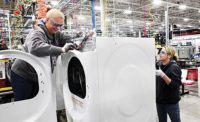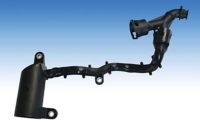One of the largest manufacturers of residential and commercial water heaters in the country, Bradford White Corp. takes safety seriously. The private, American-owned company does not sell its products directly to consumers. Instead, Bradford White water heaters are only sold to professional installers at various supply houses. This approach ensures proper product selection and safe installation of its water heaters in compliance with codes and standards.
Each year, thousands of plumbers, contractors and distributors visit Bradford White’s International Technical Excellence Center, an 18,500-square-foot training facility located next to the company’s assembly plant in Middleville, MI. As part of their training, installers get to tour the company’s assembly lines to see how water heaters are made.
“The prevailing comment we get is, ‘I didn’t realize how much it takes to build a water heater,’” says Mark Taylor, executive vice president and general manager of Bradford White.
While some water heater manufacturers have moved production out of the country, Bradford White still makes its products in the USA. Headquartered in Ambler, PA, the company employs nearly 1,800 people at manufacturing operations in Middleville; Niles, MI; and Rochester, NH. With more than 1 million square feet of manufacturing and distribution space, the Middleville operation has five assembly lines and three tank fabrication lines.
Recently, we sat down with Taylor to talk about automation, continuous improvement and quality control.
ASSEMBLY: How has the company been able to keep manufacturing in the USA?
Taylor: I would attribute it to the quality of our workforce, and the fact that we have upgraded our equipment and processes as we’ve expanded. Every piece of equipment is either new, updated with the latest controls, or completely refurbished. We have automated wherever it’s appropriate.
ASSEMBLY: Tell us more about how the company is using robotics and automation.
Taylor: Our product lines are diverse. We build water heaters with capacities ranging from 2 gallons to 200 gallons. We offer every type of power source: gas, electric, solar and heat pump products. As a result, it can be difficult to use robotics for efficiency improvements. When we invest in robotics, it’s typically to improve safety and to increase reliability and repeatability. We take efficiency gains when and where it makes sense for our operation.
ASSEMBLY: Give us an example.
Taylor: Most of our automation is directed at individual, repetitive tasks. For example, we use a stamping press to form the heads and bases for our water heaters. A robot feeds parts in and out of the press. We also use robots to place and align tanks onto water heater bases at the start of the manufacturing process. That’s especially important for gas-fired water heaters. The tank must be placed in exactly the right position on the combustion chamber to ensure that the flammable vapor ignition-resistant safety system is secure and works properly.
ASSEMBLY: Do you plan to add more automation in the future?
Taylor: We’re always looking at new technology. We will apply automation wherever it will help improve repeatability, safety or efficiency. Specifically, we’re looking at ways to automate welding processes and to automate feeding some of our metalworking equipment and assembly operations. We’re also looking at material handling technologies, such as AGVs [automated guided vehicles] and smart conveyor lines.
ASSEMBLY: What’s the most challenging aspect of making a water heater?
Taylor: If I were to focus on one thing, it would be tank fabrication and finishing. The tank is the heart of a storage water heater, so it’s extremely important that it’s made to the highest quality standards. The process for making a tank includes metal forming, welding, and enamel application and firing. We inspect every tank after each process. We check the welds. We measure the thickness, bond and dielectric strength of the enamel. And, every tank gets leak tested under pressure.
ASSEMBLY: It must be difficult to leak test something as big as a water heater tank.
Taylor: We have multiple leak test stations with multiple operators. To leak test a tank, we plug each fitting and pressurize the tank with air. Then, we use a precise mixture of soap and water to go over every inch of the weld seam. If any leaks are found, they get repaired and the tank is tested again.
ASSEMBLY: Today’s water heaters are equipped with microprocessors, intelligent diagnostics and LEDs. How has that affected your assembly process?
Taylor: We have a heat pump water heater that we began producing in 2018, and it is loaded with electronic controls and operational features. To evaluate those, we developed test loops for our assembly process in which the heaters are connected to test fixtures, powered up, and physically run through a theoretical cycle to verify that all the controls are working properly while moving down the assembly lines. All recorded test data is linked to a model and serial number and downloaded to our quality management system.
We also work with our suppliers to ensure that incoming electronic components have been tested and inspected through our ISO 9001 quality systems.
ASSEMBLY: With all the different models you make, you must be pretty good at changeover.
Taylor: Yes and no. Before we increased capacity at our plant, we primarily had three production lines. When we redesigned the plant about five years ago, we added two additional lines. Now, instead of running different types of products on one line, we’ve been able to dedicate some lines to specific products. We no longer have to change from producing gas-fired water heaters to electric ones, but we still have to do changeovers to accommodate different tank sizes.
ASSEMBLY: Bradford White products are “Built to be the Best.” How does that manifest on the assembly line?
Taylor: It may sound like a cliché, but every employee is a quality control inspector. Every assembly station on every line has a stop button, and operators have the authority to stop the line if there’s a question regarding quality, function or fit.
Before final assembly, we leak test every tank again—not just the fittings that have been installed, but we double-check all the tank-head welds. During assembly, the space between the tank and the outer casing is filled with polyol foam insulation. We use infrared cameras to make sure the foam has completely filled the cavity. On all electrical heaters, we run continuity and hi-pot tests to ensure the electrical circuit is safe and functional. On all gas products, we check all fittings for leaks, and we do functional testing to verify the pilot and main burner will light. And then finally, we test the function of the thermostat to make sure the heater will turn on and off at the set temperature before the unit is packaged and shipped.
And that’s just on the assembly line. We also do audits on returns from the field. Every unit we bring back from the field goes through a complete evaluation to determine the reason for return.
ASSEMBLY: What can you learn from auditing field returns?
Taylor: Ironically, the No. 1 thing we find is nothing—no defects. But, there are myriad other reasons a water heater might be returned. Maybe it’s the wrong size.
If we do find something that’s factory-related, we refer it to our continuous improvement program. We identify what the issue was, and we put a project team together to solve the problem.
ASSEMBLY: What manufacturing challenges does the company expect in the future?
Taylor: One of our biggest concerns is how to adapt our current facilities and processes for the products of the future. Even though a water heater is a mature appliance, we are continually adapting to new market demands. There are heat pump products, power vent products and condensing gas products. These types of new products are only going to become more prominent within our portfolio, so how do we adapt our plants for that type of volume shift and growth? And how does that translate in terms of our workforce? How do we train and adjust our workforce to make these new products?
Another concern is how the market will accept these new technologies. A lot of these changes are mandated by legislation and energy-efficiency requirements. They are dictating what the product has to be. So, we try to be proactive about it. We want our customers to know what is coming down the road. And as leaders in the industry, it’s our responsibility to help them understand and prepare for these changes.




